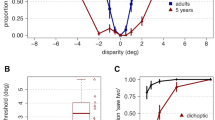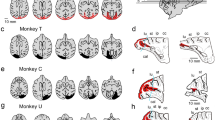Abstract
Binocular coordination of eye movements is essential for stereopsis (depth perception) and to prevent double vision. More than a century ago, Hering and Helmholtz debated the neural basis of binocular coordination. Helmholtz1 believed that each eye is controlled independently and that binocular coordination is learned. Hering2 believed that both eyes are innervated by common command signals that yoke the eye movements (Hering's law of equal innervation). Here we provide evidence that Hering's law is unlikely to be correct. We show that premotor neurons in the paramedian pontine reticular formation that were thought to encode conjugate3,4,5,6 velocity commands for saccades (rapid eye movements) actually encode monocular commands for either right or left eye saccades. However, 66% of the abducens motor neurons, which innervate the ipsilateral lateral rectus muscle, fire as a result of movements of either eye. The distribution of sensitivity to ipsilateral and contralateral eye movements across the abducens motor neuron pool may provide a basis for learning binocular coordination in infancy and adapting it throughout life.
This is a preview of subscription content, access via your institution
Access options
Subscribe to this journal
Receive 51 print issues and online access
$199.00 per year
only $3.90 per issue
Buy this article
- Purchase on Springer Link
- Instant access to full article PDF
Prices may be subject to local taxes which are calculated during checkout





Similar content being viewed by others
References
Helmholtz, J. A. Treatise on Physiological Optics (Dover, New York, (1910)).
Hering, E. The Theory of Binocular Vision (Plenum, New York, (1977)).
Henn, V., Hepp, K. & Büttner-Ennever, J. A. The primate oculomotor system II. Premotor system. Hum. Neurobiol. 1, 87–95 (1982).
Henn, V. & Cohen, B. Quantitative analysis of activity in eye muscle motoneurons during saccadic eye movements and positions of fixation. J. Neurophysiol. 36, 115–126 (1973).
Henn, V. & Cohen, B. Coding of information about rapid eye movements in the pontine reticular formation of alert monkeys. Brain Res. 108, 307–325 (1976).
Luschei, E. S. & Fuchs, A. F. Activity of brainstem neurons during eye movements of alert monkeys. J. Neurophysiol. 35, 445–461 (1972).
Fuchs, A. F. & Luschei, E. S. Firing patterns of abducens neurons of alert monkeys in relationship to horizontal eye movement. J. Neurophysiol. 33, 382–392 (1970).
Mays, L. E. & Porter, J. D. Neural control of vergence eye movements: activity of abducens and oculomotor neurons. J. Neurophysiol. 52, 743–761 (1984).
Fuchs, A. F., Kaneko, C. R. S. & Scudder, C. A. Brainstem control of saccadic eye movements. Annu. Rev. Neurosci. 8, 307–337 (1985).
Keller, E. L. Participation of medial pontine reticular formation in eye movement generation in monkey. J. Neurophysiol. 37, 316–332 (1974).
King, W. M. & Zhou, W. An ocular selectivity model of eye movement control: implications for strabismus. Soc. Neurosci. Abstr. 23, 1559 (1997).
Acknowledgements
We thank J. Cai for writing the data acquisition software; C. Drake for care of our animals; B.-F. Tang and J. Alison for technical support; and M. Goldberg and P. May for comments on a preliminary version of this manuscript. This research was supported by NIH and ONR grants to W.M.K.
Author information
Authors and Affiliations
Corresponding author
Rights and permissions
About this article
Cite this article
Zhou, W., King, W. Premotor commands encode monocular eye movements. Nature 393, 692–695 (1998). https://doi.org/10.1038/31489
Received:
Accepted:
Issue Date:
DOI: https://doi.org/10.1038/31489
This article is cited by
-
A covered eye fails to follow an object moving in depth
Scientific Reports (2021)
-
A distributed saccade-associated network encodes high velocity conjugate and monocular eye movements in the zebrafish hindbrain
Scientific Reports (2021)
-
Functional architecture underlying binocular coordination of eye position and velocity in the larval zebrafish hindbrain
BMC Biology (2019)
-
On the role of ocular torsion in binocular visual matching
Scientific Reports (2018)
-
A rare cause for visual symptoms in multiple sclerosis: posterior internuclear ophthalmoplegia of Lutz, a historical misnomer
Journal of Neurology (2017)
Comments
By submitting a comment you agree to abide by our Terms and Community Guidelines. If you find something abusive or that does not comply with our terms or guidelines please flag it as inappropriate.



